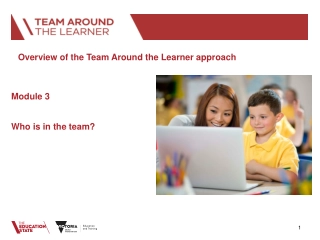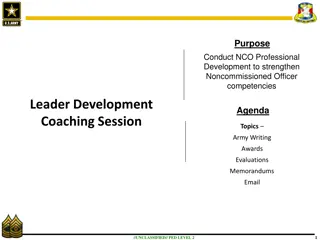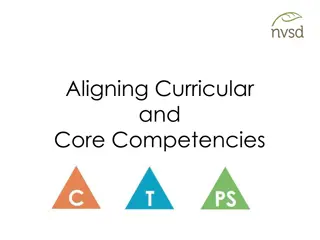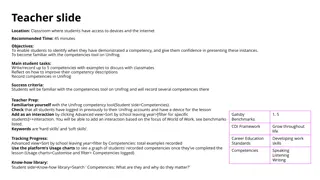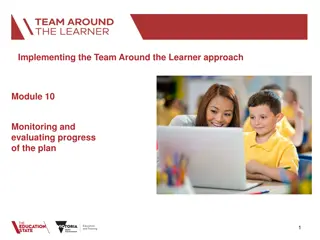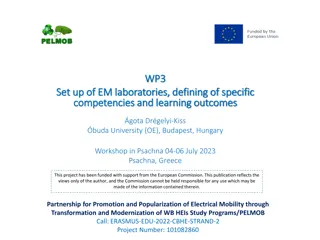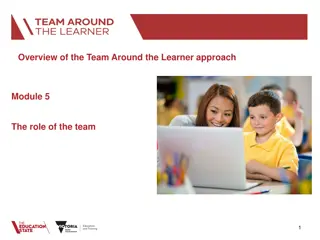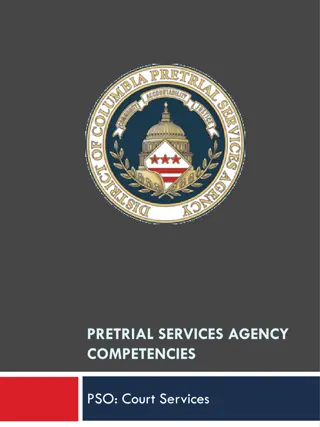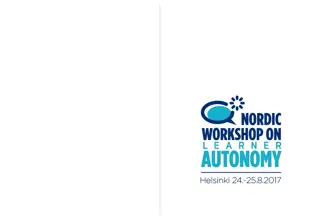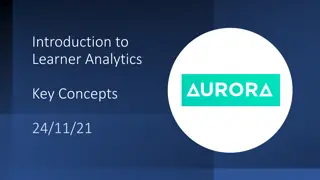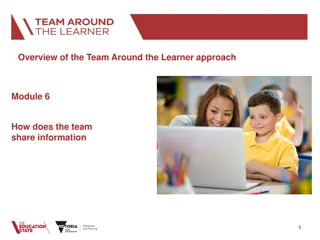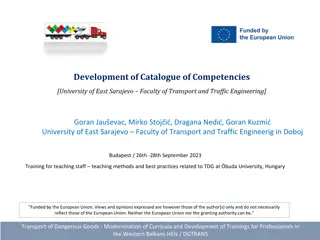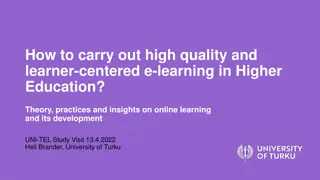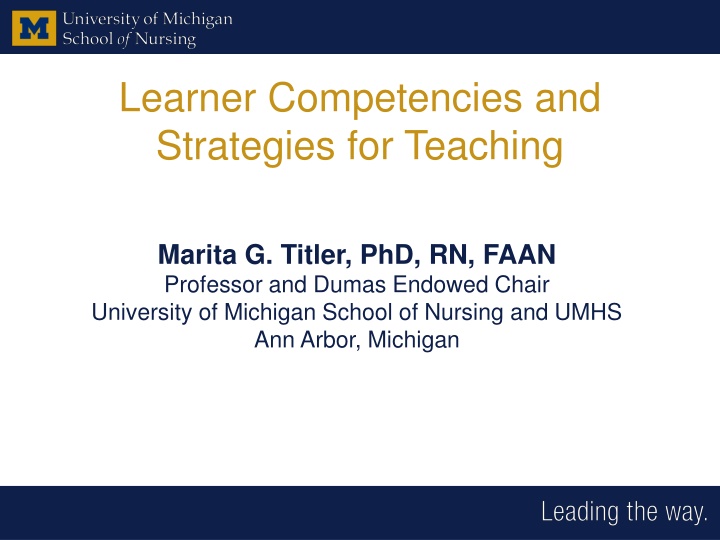
Learner Competencies and Teaching Strategies for Nursing Education
Enhance your understanding of nursing education with essential competencies and teaching strategies related to evidence-based practice, research process, and credibility of information sources. Explore how to identify credible internet sources, compare literature databases, and find relevant literature on specific topics.
Download Presentation

Please find below an Image/Link to download the presentation.
The content on the website is provided AS IS for your information and personal use only. It may not be sold, licensed, or shared on other websites without obtaining consent from the author. If you encounter any issues during the download, it is possible that the publisher has removed the file from their server.
You are allowed to download the files provided on this website for personal or commercial use, subject to the condition that they are used lawfully. All files are the property of their respective owners.
The content on the website is provided AS IS for your information and personal use only. It may not be sold, licensed, or shared on other websites without obtaining consent from the author.
E N D
Presentation Transcript
Learner Competencies and Strategies for Teaching Marita G. Titler, PhD, RN, FAAN Professor and Dumas Endowed Chair University of Michigan School of Nursing and UMHS Ann Arbor, Michigan
AACN Essentials Baccalaureate Essential 3: Scholarship for EBP Rationale: Professional nursing practice is grounded in the translation of current evidence into practice. Scholarship for the baccalaureate graduate involves identification of practice issues appraisal and integration of evidence and evaluation of outcomes.
AACN Essentials Essential 3: Scholarship for EBP Demonstrate an understanding of the basic elements of the research process and models for applying evidence to clinical practice. Evaluate the credibility of sources of information, including but not limited to databases and Internet resources. Participate in the process of retrieval, appraisal, and synthesis of evidence in collaboration with other members of the healthcare team to improve patient outcomes. Integrate evidence, clinical judgment, interprofessional perspectives, and patient preferences in planning, implementing, and evaluating outcomes of care.
Essential 3: Evaluate the credibility of sources of information, including but not limited to databases and Internet resources. Competency: Identify credible internet sources of evidence for practice. Obj: Compare and contrast internet sources of evidence. Teaching strategy: Compare AHRQ; CDC; and an advocacy group website (e.g. fibromyalgia; http://www.fmaware.org)
Compare AHRQ; CDC; and an advocacy group website Who are the developers Are there advertisements on the website Who is the website targeted to What type of evidence sources are available on each site Which sites are credible sources of evidence for clinicians
Evaluate the credibility of sources of information, including but not limited to databases and Internet resources. Competency: Use literature databases to search for evidence on specified topics Learning objectives: Compare and contrast literature databases (e.g. Pubmed; CINHAL; Medline). Find published literature on [topic] Find research reports on [topic]
Teaching Strategies: Bacc students Beginning level student Find 3 articles on pressure ulcer prevention in PubMed, and CINHAL using the same search terms Describe the above search databases Intermediate student Find research reports on pressure ulcer prevention; select 3 applicable to patient population Turn in search strategies
Teaching Strategies- Bacc Students Senior level students Do a search to locate research on pressure ulcer prevention Find clinical trials on pressure ulcer prevention Find systematic reviews or EBP guidelines on PU prevention
AACN Essentials Essential 3: Scholarship for EBP Demonstrate an understanding of the basic elements of the research process and models for applying evidence to clinical practice. Evaluate the credibility of sources of information, including but not limited to databases and Internet resources. Participate in the process of retrieval, appraisal, and synthesis of evidence in collaboration with other members of the healthcare team to improve patient outcomes. Integrate evidence, clinical judgment, interprofessional perspectives, and patient preferences in planning, implementing, and evaluating outcomes of care.
Demonstrate an understanding of the basic elements of the research process and models for applying evidence to clinical practice. Competency: Identify essential steps in research Learning Objectives: Compare and contrast observational studies, quasi-experimental studies, randomized clinical trials Teaching strategies: Jeopardy
Jeopardy Study included 300 people who were hospitalized (what is sample size) The study did not include people < 18 years of age (what is exclusion criteria) The study included the following table: Group Mean (SD) Experimental 84.2 (3.1) Control 70.1 (6.8)
Jeopardy Game The research report did not include a comparison group (what is an observational study) The study included the following: Do people with green eyes have more fun than those with brown eyes (what is the research question)
Jeopardy Game WHAT IS THIS? (Conceptual model)
Demonstrate an understanding of the basic elements of the research process and models for applying evidence to clinical practice. Competency: Identify models of EBP; Learning objective: Identify the 3 main constructs of the PARIHS model and the components of each. Teaching strategy: Write a 3 page paper. Skit/Charades: Teams of performing (act out each part/construct; audience participation).
AACN Essentials Essential 3: Scholarship for EBP Demonstrate an understanding of the basic elements of the research process and models for applying evidence to clinical practice. Evaluate the credibility of sources of information, including but not limited to databases and Internet resources. Participate in the process of retrieval, appraisal, and synthesis of evidence in collaboration with other members of the healthcare team to improve patient outcomes. Integrate evidence, clinical judgment, interprofessional perspectives, and patient preferences in planning, implementing, and evaluating outcomes of care.
Integrate evidence, clinical judgment, interprofessional perspectives, and patient preferences in planning, implementing, and evaluating outcomes of care. Competency: Application to care of patients in clinical rotations Learning objective: Apply the evidence for fall prevention in combination with clinical judgment, patient preferences etc in older adults on medical-surgical units. Teaching: Observation and discussions in clinical.
AACN Essentials Essential 3: Scholarship for EBP Demonstrate an understanding of the basic elements of the research process and models for applying evidence to clinical practice. Evaluate the credibility of sources of information, including but not limited to databases and Internet resources. Participate in the process of retrieval, appraisal, and synthesis of evidence in collaboration with other members of the healthcare team to improve patient outcomes. Integrate evidence, clinical judgment, interprofessional perspectives, and patient preferences in planning, implementing, and evaluating outcomes of care.
Participate in the process of retrieval, appraisal, and synthesis of evidence in collaboration with other members of the healthcare team to improve patient outcomes. Competency: Learning Objective: Teaching strategy:
AACN Essentials Essential 3. Scholarship for EBP Collaborate in the collection, documentation, and dissemination of evidence. Acquire an understanding of the process for how nursing and related healthcare quality and safety measures are developed, validated, and endorsed. Describe mechanisms to resolve identified practice discrepancies between identified standards and practice that may adversely impact patient outcomes.
Acquire an understanding of the process for how nursing and related healthcare quality and safety measures are developed, validated, and endorsed Competency: Identify 3 quality outcome measures that are nurse sensitive Learning objective: Define the conceptual and operational definition of each. Teaching strategies: Review National Quality Forum Website What is NQF How are each of these measures defined
Acquire an understanding of the process for how nursing and related healthcare quality and safety measures are developed, validated, and endorsed Competency: Learning Objective: Teaching Strategies:
AACN Essentials Essential 3. Scholarship for EBP Collaborate in the collection, documentation, and dissemination of evidence. Acquire an understanding of the process for how nursing and related healthcare quality and safety measures are developed, validated, and endorsed. Describe mechanisms to resolve identified practice discrepancies between identified standards and practice that may adversely impact patient outcomes.
Describe mechanisms to resolve identified practice discrepancies between identified standards and practice that may adversely impact patient outcomes. Competency: Learning Objective: Teaching strategy:
AACN Masters Essentials: Rationale Essential IV: Translating and Integrating Scholarship into Practice Recognizes that the master s-prepared nurse applies research outcomes within the practice setting, resolves practice problems, works as a change agent, and disseminates results.
Masters Essentials (IV) Integrate theory, evidence, clinical judgment, research, & interprofessional perspectives using translational processes to improve practice and associated health outcomes for patient aggregates. Articulate to a variety of audiences the evidence base for practice decisions, including the credibility of sources of information and the relevance to the practice problem confronted.
Articulate to a variety of audiences the evidence base for practice decisions, including the credibility of sources of information and the relevance to the practice problem confronted. Competency: Able to articulate the evidence base and evidence sources for common health issues/problems in specialty area. Learning objective: Describe to a family member or patient the treatment options for [topic] Teaching strategy: High fidelity simulation.
Articulate to a variety of audiences the evidence base for practice decisions, including the credibility of evidence sources and the relevance to practice issue Competency: Apply the evidence, and credibility of evidence about dementia care. Learning objective: Synthesize evidence for practice Teaching Strategy: Write an EB practice standard
Masters Essentials (IV) Apply practice guidelines to improve practice and the care environment. Articulate to a variety of audiences the evidence base for practice decisions, including the credibility of sources of information and the relevance to the practice problem confronted.
Apply practice guidelines to improve practice and the care environment. Competency: Differentiate between high, credible guidelines and low credible guidelines. Learning objective: Apply the AGREE tool to critique of EBP guidelines Teaching strategy: Group critique; individual critique with paper; class presentation; clinical rotations.
DNP Essential III: Clinical Scholarship and Analytic Methods for EBP Use analytic methods to critically appraise existing literature and other evidence to determine and implement the best evidence for practice. Design and implement processes to evaluate outcomes of practice, practice patterns, and systems of care within a practice setting, health care organization, or community against national benchmarks to determine variances in practice outcomes and population trends. Design, direct, and evaluate quality improvement methodologies to promote safe, timely, effective, efficient, equitable, and patient-centered care.
Use analytic methods to critically appraise existing literature and other evidence to determine and implement the best evidence for practice. Competency: Critically appraise and implement evidence in practice to improve patient outcomes. Learning objective: Lead the critical appraisal and application of evidence for a specified care issue/patient problem Teaching: Capstone project
Other Thoughts About Teaching Strategies Research article applicable to patient(s) care for in clinical. Seminar reading and critiquing research Critique of a practice guideline Faculty presentations include the evidence-base for the topic (e.g. patient education; self-care management)
Other Thoughts About Teaching Strategies Provide articles on a topic (e.g. falls) and have students differentiate between a clinical article, research report, systematic review, and practice guidelines. Integration into skills labs and simulation Case-based learning
Application Select a course you are teaching (identify level of learner). Identify 2 learning objectives with respect to EBP for the course Describe teaching strategies to meet the objectives. Identify a clinical rotation you teach Select learning objectives and teaching strategies

